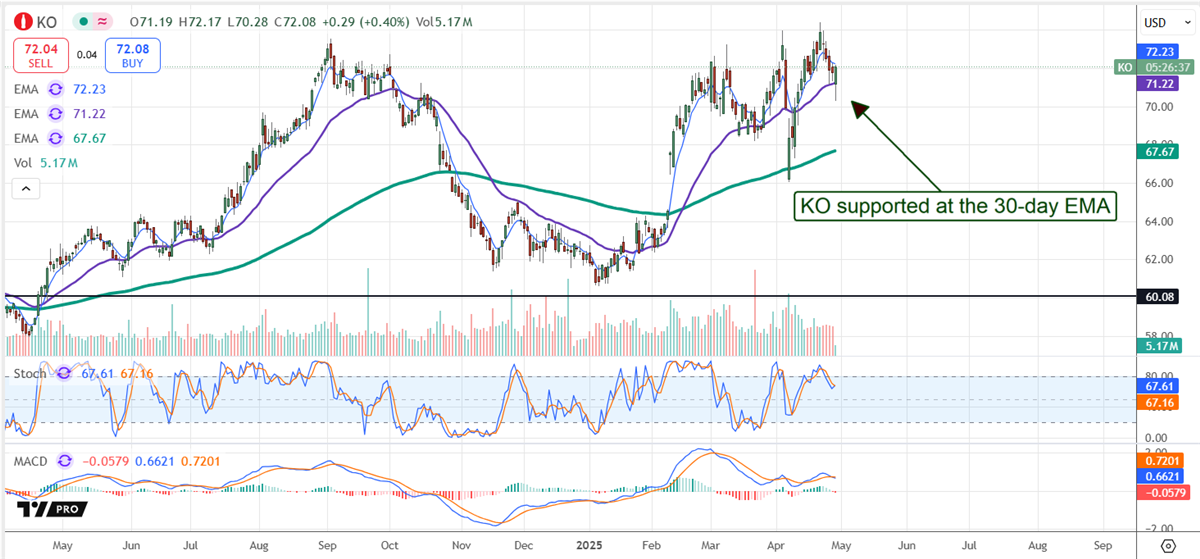 Recent upticks in the market may disguise the ongoing risks that remain for investors; these factors point to the importance of a defensive... ͏ ͏ ͏ ͏ ͏ ͏ ͏ ͏ ͏ ͏ ͏ ͏ ͏ ͏ ͏ ͏ ͏ ͏ ͏ ͏ ͏ ͏ ͏ ͏ ͏ ͏ ͏ ͏ ͏ ͏ ͏ ͏ ͏ ͏ ͏ ͏ ͏ ͏ ͏ ͏ ͏ ͏ ͏ ͏ ͏ ͏ ͏ ͏ ͏ ͏ ͏ ͏ ͏ ͏ ͏ ͏ ͏ ͏ ͏ ͏ ͏ ͏ ͏ ͏ ͏ ͏ ͏ ͏ ͏ ͏ ͏ ͏ ͏ ͏ ͏ ͏ ͏ ͏ ͏ ͏ ͏ ͏ ͏ ͏ ͏ ͏ ͏ ͏ ͏ ͏ ͏ ͏ ͏ ͏ ͏ ͏ ͏ ͏ ͏ ͏ |
| | Written by Nathan Reiff 
A late April 2025 rally in the S&P 500 has sparked a wave of investor optimism, with some asserting that the market has fully absorbed the effects of President Trump’s tariffs. However, this optimism may be premature. Key indicators point to significant headwinds ahead. Entrenched inflation and a resolutely hawkish Federal Reserve, lackluster corporate earnings accompanied by downward revisions, escalating geopolitical tensions, and the looming risk that tariffs impact U.S. consumers have yet to materialize. These factors suggest the market's challenges are far from over. Investors eyeing a defensive posture, such as allocating capital to physical gold or traditionally resilient sectors like utilities, have compelling reasons to prepare for turbulence in the near term. Sticky Inflation and a Resistant Fed Despite the Federal Reserve’s aggressive rate hikes in recent quarters, inflation has proven more resilient than anticipated, with the Consumer Price Index rising 2.4% year-over-year in March. The Fed has made it clear: rate cuts are unlikely until inflation decisively moves closer to its 2% target. This stance, which stands in direct contrast to President Trump’s vocal demands for lower rates, poses a dual threat, pressuring equity valuations and constraining consumer spending. Moreover, if expectations of imminent rate cuts have underpinned recent market strength, any shift in that outlook could spark renewed volatility across asset classes. Weak Earnings and Downward Revisions Across multiple sectors, several companies have underperformed in the most recent quarter due to declining profits and revenue misses, among other factors. Airline companies Finnair and American Airlines Group (NASDAQ: AAL) each posted losses, with the latter among several U.S. carriers to withdraw its full-year 2025 forward guidance due to uncertainty in the market. Pharmaceuticals giant Bristol-Myers Squibb Co. (NYSE: BMY) also noted a quarterly loss while slashing its full-year earnings estimates and announced plans to cut up to 2,200 positions. Meanwhile, electronics maker Kimball Electronics Inc. (NASDAQ: KE) also reported disappointing net sales, lowered due to dwindling sales across its industrial, medical, and automotive lines amid ongoing tariff concerns. To be clear, not every company reporting first-quarter 2025 earnings has missed analyst expectations. However, with each successive firm, industry, or sector that delivers disappointing results, the broader perception of market health continues to deteriorate, heightening concerns about the strength and sustainability of the current economic expansion. Geopolitical Risks Remain—and Grow One of the most pressing geopolitical risks facing U.S. consumers and businesses is the escalating trade conflict between the Trump administration and China. As of late April 2025, the U.S. has imposed tariffs of at least 145% on Chinese imports, affecting approximately $440 billion of goods based on 2024 figures. With no meaningful progress toward a trade resolution, it is increasingly unlikely that consumers or importers will soon see relief from these elevated costs. Meanwhile, instability in the Middle East continues to rattle energy markets. Although oil prices have recently declined, driven partly by increased production from OPEC+ nations, underlying tensions remain acute. Heightened friction between the United States and Iran, coupled with ongoing conflict in Gaza, threatens to inject further volatility into an already fragile global energy landscape. Tariff Uncertainty Continues Markets experienced significant turbulence earlier this year with a wave of tariff announcements affecting imports from various countries. Following a series of rapid-fire declarations and subsequent pauses by the Trump administration in early April, the U.S. has since embarked on a flurry of trade negotiations with dozens of nations. However, unless these agreements materialize, the suspended tariffs are expected to be reinstated later in the year, setting the stage for renewed market volatility. The U.S.-China tariff landscape is also poised to intensify. Should the administration expand duties on critical technology imports, consumers could face sharp price increases on electronics and other tech goods. At the same time, Beijing’s potential retaliatory measures, particularly restrictions on exports of rare earth minerals essential to high-tech manufacturing, pose a serious threat to supply chains and could severely impact select technology firms and broader equity markets.  Read This Story Online Read This Story Online | |
| Written by Thomas Hughes 
Coca-Cola’s (NYSE: KO) stock price can bubble to new highs this year because its Q1 results and guidance update show its everywhere-is-local approach to business and international growth agenda is working. The company faces headwinds in 2025 like virtually every other S&P 500 business, yet it still produces industry-leading organic growth, solid margin, and optimistic guidance. The company updated its 2025 outlook to include the impact of FX headwinds and macroeconomic factors, but reaffirmed its growth and earnings targets, stating that the impacts were manageable. The takeaway for investors is that the Coca-Cola Company is expected to grow 5% to 6% organically this year and maintain a slightly faster pace on the bottom line. The Coca-Cola Company Grows, Increases Share, Guides Favorably The Coca-Cola Company’s reported results don't fully reflect its underlying strength. The company’s revenue contracted by 2% on a reported basis, slightly below consensus figures, but is offset by positive internal metrics, including case volume, concentrate sales, and organic revenue growth. The company grew 6% organically, driven by a 5% increase in price and mix, as well as a 1% increase in concentrate sales. Global unit case volume grew by 2% and is expected to remain strong this year. Efforts to capture share at major regional events are paying off, with increased sales and market share expected to drive leveraged top-line growth when macroeconomic headwinds ease. The margin news is better. The company’s localized approach to bottling and delivery and operational quality improvements helped offset headwinds, including a 500-basis-point impact from FX conversion. The critical details are that FX-neutral operating income grew by 10%, the comparable operating margin improved by 140 basis points, and adjusted EPS of $0.73 is up 1% year-over-year, despite a contraction in the top line. Coca-Cola’s Dividend Growth is Reliable in 2025 Coca-Cola’s status as a Dividend King is among its attractions. The Q1 results and guidance align with the outlook for distribution sustainability, including the low single-digit compound annual growth rate (CAGR). Share repurchases are also in the equation, at least offsetting the count and reducing it incrementally in Q1 2025 and for the full fiscal year in 2024. Regarding the balance sheet, the company’s debt level remains manageable at 1.55x equity, and equity increased by 5%. The KO analysts' trends are unlikely to change because of these results and the outlook. They are strongly bullish, with increasing coverage, firming sentiment following recent upgrades to Buy or Strong Buy levels, and an upward trend in price target revisions. The consensus reported by MarketBeat is a Buy, with a bias toward Strong Buy, due to the low number of Hold or Sell ratings (5% of 20 analysts) and the increasing number of Strong Buys. The consensus price target is significant because it has increased by 10% in 12 months, putting the market at an all-time high, with the high-end range adding more than 10%. The Coca-Cola Company Can Set New Highs Before the Second Half The price action in KO stock showed some weakness early in the session following the release, but quickly regained its footing. The subsequent action shows support at critical levels, including the 30-day EMA and setting up for a run to new highs. A move to new highs could come before the end of the quarter and lead to a sustained rally in the second half. In this scenario, this market could move to the high end of the analysts' range, near $85, and potentially higher if positive news regarding tariffs or trade emerges. 
 Read This Story Online Read This Story Online | If you're not familiar with how to build a strong, reliable dividend portfolio… or where to begin…
We've got the hookup for you.
A young investor who's obsessed with dividends put together a set of 5 dividend "cheat sheets" meant to take you from 0 to what could be a full blown dividend portfolio as quickly as possible…
The best part?
Right now, the five dividend cheat sheets are FREE  Grab your copies HERE right now. Grab your copies HERE right now. |
| Written by Leo Miller 
With tariffs causing markets to waver in 2025, many investors were growing worried about the guidance companies would put out. Analysts expect certain stocks not to give guidance for the rest of the year due to the difficulty in forecasting amid the tariff policy environment. Additionally, many stocks are likely to lower their guidance. However, with the Q1 2025 earnings season now ramping up, several companies are bucking the uncertainty narrative. This analysis will cover three stocks that increased their guidance, even with tough market conditions. Philip Morris: The Gift That Keeps on Giving in 2025 First up is Philip Morris International (NYSE: PM). This company crushed its earnings on all fronts. Its adjusted earnings per share (EPS) of $1.69 beat estimates by $0.08, while revenue of $9.3 billion came in $150 million above expectations. The company also raised its full-year adjusted EPS guidance to a midpoint of $7.43. This midpoint was around 6% higher than the midpoint the firm previously forecasted. The company’s total revenue projection of over $40.5 billion was around $300 million higher than expected. The company’s smokeless product line, which includes ZYN nicotine pouches, continues to grow impressively in sales. Organic sales growth among these products was over 20%, compared to less than 4% growth for its combustible products. Overall, the company said it doesn’t expect any material impact on its business due to “recently introduced or discussed tariffs”. Philip Morris has been an incredible performer in 2025, with a total return of approximately 42% as of the April 28 close. However, that didn’t stop Wall Street from considerably upgrading the stock after its April 23 earnings. Several analysts tracked by MarketBeat did so, and on average, their new targets imply 6% upside in shares versus the stock’s April 28 closing price. Vertiv: AI-Data Center Demand Keeps Chugging Along Next up is Vertiv (NYSE: VRT). The company beat estimates in its Q1 earnings handily. Sales hit $2.04 billion, about $100 million more than expected. Adjusted EPS reached $0.64, exceeding expectations by roughly 5%. Not only did the firm have a strong Q1, but it also raised its expectations going forward. The company significantly raised its revenue guidance for the full year. Its midpoint revenue projection now sits at $9.45 billion, around $250 million higher than it had previously expected. Additionally, the firm widened its range of adjusted EPS outcomes by $0.05 on both sides. Overall, the company maintained its midpoint adjusted EPS guidance of $3.55. Vertiv’s results show no sign of a big drop in spending on AI-related data center infrastructure. The company’s revenue grew by over 24%. This was the second-fastest increase in the last eight quarters. It was only a small drop from the nearly 26% growth in Q4 2024. The company also continues to see robust demand when looking at orders. Vertiv’s backlog increased by about $1.6 billion vs Q1 2024 and was up 10% vs Q4 2024. In total, the figure sits at $7.9 billion. Ultimately, the firm raised its sales guidance due to the robust demand it is seeing. However, it widened its range on earnings guidance due to tariffs and the uncertainty they create. The company is actively working to mitigate tariffs, but the extent to which it will be able to do so remains to be seen. Boston Scientific: Beat, Raise, and +15% Upside Last up is Boston Scientific (NYSE: BSX). The healthcare company also beat adjusted EPS and sales estimates by a significant margin. Adjusted EPS of $0.75 was $0.08 higher than anticipated, and sales of $4.66 billion were around $90 million above estimates. For the full year, sales growth guidance came in at a midpoint figure of 16%. This compares to the previous estimate of 13.5% growth. Additionally, adjusted EPS guidance was set at a midpoint of $2.91, up from the $2.84 expected before. All price target updates for Boston Scientific monitored by MarketBeat after earnings were either hikes or reiterations. These updated price targets signal average upside in shares of over 16% compared to the stock’s April 28 closing price. The company raised its guidance, noting the “significant strength” of its cardiology portfolio. Sales for this portfolio grew by almost 30%. The firm said that it sees a $200 million impact as a result of tariffs. It believes that higher sales guidance, cuts in discretionary spending, and foreign exchange gains will fully offset this impact. Overall, it is highly encouraging to see these companies raise guidance, especially during a period in which guidance expectations are decidedly negative.  Read This Story Online Read This Story Online | What's happening in the markets right now should concern every freedom-loving American who's worked hard and saved smart.
Your 401(k) doesn't deserve to be dragged through the mud by tariffs, trade wars, reckless spending, and political standoffs.
And you don't have to stand by while Wall Street plays roulette with your future. The Golden Path to Retirement gives you the whole story. |
| More Stories |
| |
|
|